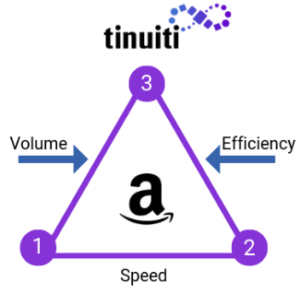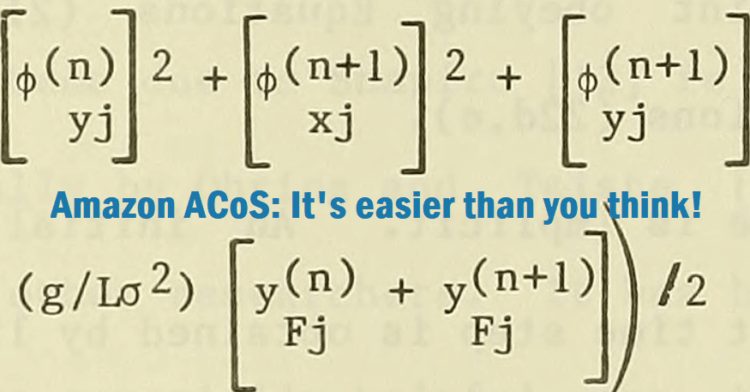When you’re measuring your performance on Amazon, advertising cost of sale (ACoS) is one of the most important metrics to keep track of. It can determine the effectiveness (or ineffectiveness) of your advertising campaigns, and impact how well you’re scaling towards your business goals.
Here’s a quick look at how you should interpret ACoS, how to calculate it, and the steps you can take to lower your ACoS to make your advertising campaigns more efficient.
What is Amazon ACoS?
Advertising cost of sale (ACoS) is the average percentage of each sale that you pay towards advertising to make that sale.
ACoS is essential to measuring and evaluating the success of your Amazon advertising campaigns, as well as for making the necessary adjustments for optimizing those campaigns.
“ACoS is an important metric to track within your business since it describes the efficiency of your advertising strategy,” explains Daniel Creviston, Marketplace Channel Analyst at Tinuiti.
So what is considered a good ACoS?
Generally speaking, a low ACoS is a good ACoS. However, what you determine as “low” may vary by product and your goals.
The lower your ACoS, the less you’re spending on advertising for that sale. That means your campaigns and keyword targeting are efficient. A higher ACoS, on the other hand, can mean your advertising campaigns are inefficient, possibly due to keywords or campaign structure.
With that said, here some general ACoS benchmarks:
- A low ACoS is under 25%. If you’re under 25% for ACoS, then conversions are high for that keyword or product. You may want to consider raising your bid to increase clicks and overall traffic for that term/product.
- An average ACoS is between 25% to 40%.
- A high ACoS is above 40%. This might happen when a specific keyword is gaining a lot of traffic, but has a low conversion rate. This represents a good opportunity to rethink the keywords you’re currently bidding on.
How to Calculate Amazon ACoS.
Simply put, ACoS is calculated using the following formula:
ACoS = 100 ( [total ad spend] ÷ [total sales] )
In other words, if you spend $50 on advertising and it resulted in a single sale of $100, your ACoS would be 50%:
100 x ([50] ÷ [100]) = 100 x 0.5 = 50%
If you want to calculate your ACoS automatically though, check out Tinuiti’s FREE Amazon ACoS Calculator. And to make it really easy for you, we created a video demonstrating how to use it:
Lowering ACoS & the “Amazon Advertising Triangle”.
One thing we commonly hear from sellers is, “I want to achieve improvements in both volume (increasing orders/revenue) and [Return on Investment] (decrease ACoS) – and I want to accomplish this quickly!”
However, volume and efficiency can be competing goals. Working towards one can undermine the success of the other.

For that reason, you need to ask yourself: are my goals growth-based (volume) or ROI-based (efficiency). Because, as Creviston stated, “Unless your business is focused on growing sales without concern for profit, in which case you would expect a high ACoS, lowering your ACoS will ultimately increase your bottom line.”
For example, if you’re launching a new product, you might sacrifice profitability for volume and speed. The goal during launch is usually to get as many eyes as possible on your product. You’re trying to build awareness quickly, which contributes to a higher ACoS.
Conversely, if you are on a tight budget and need to hit revenue targets, you want to get your ACoS as low as possible. You want to make the most efficient use of your marketing dollars on Amazon. This requires adjusting your bids for keywords or product targeting that aren’t converting well.
“You can effectively lower your ACoS by identifying campaigns with a high ACoS and then decreasing bids or performing negative keyword harvests for those campaigns to eliminate wasted spend.”
– Daniel Creviston
Final takeaways
ACoS is an important metric for evaluating the success of your advertising campaigns on Amazon. But it’s equally important to view your ACoS in the context of your overall goals.
For sellers who want to grow quickly, or build awareness for a product listing by driving traffic to it, a higher ACoS is inevitable.
However, if your goal is to minimize wasted ad spend and hit ROI targets, then lower your ACoS is possible. By adjusting bids for keywords or product targeting that aren’t converting efficiently, you can lower your costs.
To sum it all up:
- A good ACoS is relative to your marketing and business goals.
- A high ACoS is acceptable if your goals are volume and speed for faster growth.
- If you want to lower your ACoS for efficiency goals, you need to adjust bids for low converting keywords.
- Total profitability > Lower ACoS.
If you’ve had success lower your ACoS using alternate methods, please share them in the comment section below. We’d love to hear from you!
Author Greg Swan is a Content Specialist at Tinuiti.


 No Comments
No Comments